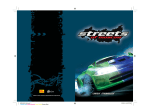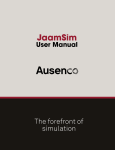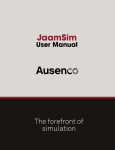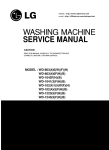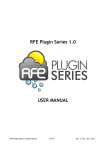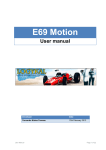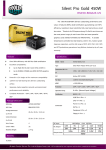Download WSC` 12 Preparing Manuscripts
Transcript
Proceedings of the 2013 Winter Simulation Conference
R. Pasupathy, S.-H. Kim, A. Tolk, R. Hill, and M. E. Kuhl, eds
OPEN-SOURCE SIMULATION SOFTWARE “JAAMSIM”
D. H. King
Harvey S. Harrison
Ausenco
855 Homer Street
Vancouver, BC, V6B 2W2, CANADA
Ausenco
855 Homer Street
Vancouver, BC, V6B 2W2, CANADA
ABSTRACT
JaamSim is a free, open-source simulation package written in the Java programming language. A modern
graphical user interface is provided that is comparable to commercial software, including drag-and-drop
model building, an Input Editor, Output Viewer, and 3D graphics. Users are able to create their own palettes of high-level objects using standard Java and modern programming tools such as Eclipse. If you are
writing hundreds or thousands of lines of code in a proprietary programming language provided with your
commercial software, you would be far better off to write your code in Java and use JaamSim.
1
INTRODUCTION
This paper introduces ‘JaamSim’, a free, open-source simulation package developed by the Ausenco, a
global engineering company. JaamSim is aimed at a broad audience of professionals, researchers, and
students, and includes a modern graphical user interface (GUI) that is comparable to those provided by
commercial off-the-shelf simulation software. The software is written in the Java programming language
and can be downloaded from Github. The executable, user manual, programming manual, and examples
are available from the authors on request.
The key feature that makes JaamSim different from commercial off-the-shelf simulation software is
that it promotes the development customized palettes of high-level objects for new applications. New objects automatically have 3D graphics, can be dragged-and-dropped, have their inputs editable through the
Input Editor, and their outputs displayed in the Output Viewer. Programming is done in standard Java using modern development tools such as Eclipse. Unlike commercial simulation software, JaamSim is not
restricted by the idiosyncrasies and limited feature set of a proprietary programming or scripting language.
JaamSim was developed from Ausenco’s ‘Transportation Logistics Simulator’ (TLS) software that
we use to model mine-to-port and port-to-port supply chain studies for the Mining and Oil & Gas industries. Everything in TLS that is generic in nature, and not related to supply chains was transferred to
JaamSim. It includes all the discrete-event logic, input and output handling, programming tools, userinterface, 3D graphics, and palettes of basic objects. TLS became a collection of add-on palettes for
JaamSim containing objects for ships, berths, stockpiles, railways, etc. A good way to assess the capabilities of JaamSim is to view our TLS models on YouTube. Apart from the specialized objects, everything
you see in these videos is available in JaamSim.
JaamSim is not the first open source simulation offering in Java. Previous open source simulation
engines in Java include: CSIM, DESMO-J, DEUS, DSOL, JavaSim, JiST, Jsim, JSL, SimJava, Simkit,
SSJ, and Tortuga. However, to the best of our knowledge, JaamSim is the first to provide the modern
GUI required for the software to have a wide appeal.
King and Harrison
2
INSTALLING AND USING JAAMSIM
JaamSim is an extremely light-weight application consisting of a single 10MB executable, including all
dependencies. The executable can be copied directly to the user's computer. No special installation program is required. JaamSim will run on most modern computers that support OpenGL graphics version
3.0 or later, including laptop computers with Intel Core i5 and i7 series processors that rely on integrated
graphics.
The graphical user interface (GUI) for JaamSim provides all the necessary tools for model building:
• Control Panel – the main interface to JaamSim that controls the execution of models and provides
access to the other GUI components
• Views – one or more windows showing 3D views of the model universe
• Model Builder – tool for dragging and dropping model components
• Object Selector – provides access to each object in the model
• Input Editor – displays the inputs to the selected object and permits editing
• Output Viewer – displays the present value for the outputs from the selected object
• Property Viewer – debugging tool that displays all the internal properties for the selected object
A number of built-in palettes of objects are provided in the Model Builder:
• Graphics components – 2D and 3D components such as maps, structures, graphs, text, and model
outputs
• 2D Overlay Graphics – 2D components that appear in a fixed position in a View window
• Probability Distributions – standard probability distributions and user-defined distributions
• Basic Process Flow Components – queue, server, source, sink, conveyor, etc.
• Mathematics and Control System Components – integration, addition, PID controller, etc.
• Fluid Flow Components – tanks, pipes, pumps, fluids, etc.
We frequently create new palettes of objects to support our modeling projects, many of which are
added to JaamSim. More information on object palettes and the GUI can be found in the JaamSim User
Manual.
3
MODEL INPUTS AND OUTPUTS
There is no question that the easiest and fastest way to build a simple model is to drag and drop the individual objects and use the Input Editor to set their parameters. However, this method because less attractive for more complex models where the graphics become cluttered and the inputs very numerous. For a
really large model containing hundreds of objects, it is usually necessary to build the model through an
input file. Sometimes, a hybrid approach works best – assemble the basic objects and graphical presentation using the GUI and then add more detailed inputs and additional objects using the input file. Either
way, the only practical way to ensure that the inputs to a large model are correct is to audit the input file
line by line.
JaamSim allows models to be constructed either through the GUI or an input file. The input file uses
an object-keyword-value structure. For example, the following lines of input:
Define Ship { LargeShip }
LargeShip Length { 300 m }
would define the object “LargeShip” (an instance of “Ship”) and assign the value three hundred meters to
its “Length” input. Note that all model inputs are assigned units where appropriate and unit conversions
are done automatically by the program. Internal calculations are done in SI units by JaamSim.
The Input Editor uses the same object-keyword-value structure as the input file. The following figure
shows an example of the Input Editor.
King and Harrison
Figure 1 Input Editor
In this example, the Input Editor was opened for the object “Queue-1”, which has its keywords organized into the categories “Basic Graphics” and “Key Inputs”. The tooltip pop-up shows the definition of
the keyword “Alignment” and an example of its use. Definitions are given in this way for all model inputs and outputs. The software uses annotations to encode this material, thereby making the program
largely self-documenting.
Model inputs are changed by clicking on the entry in the Value column and typing an new value.
Drop down menus are provided whenever possible depending on the type of input.
4
EXAMPLE MODEL
Having discussed the basics of a JaamSim model, it is appropriate to show a simple example. The following model for a simple harmonic oscillator is one of the example models provided with JaamSim.
Figure 2: Harmonic Oscillator Example
King and Harrison
In this example, the variables position, velocity, and acceleration are updated every 0.01 seconds by
the controller shown in the bottom left of the screen. The key inputs used to create this model, excluding
graphics, are given by the following entries in the input file:
“ DEFINITIONS
Define Controller { Controller-1 }
Define Integrator { VelocityIntegrator PositionIntegrator }
Define WeightedSum { AccelerationSum }
“ CONTROLLER INPUTS
Controller-1 SamplingTime
{ 0.01 s }
“ VELOCITY INTEGRATOR INPUTS
VelocityIntegrator Controller
{ Controller-1 }
VelocityIntegrator SequenceNumber { 1 }
VelocityIntegrator InputValue
{ AccelerationSum }
VelocityIntegrator InitialValue
{ 0 }
“ POSITION INTEGRATOR INPUTS
PositionIntegrator Controller
{ Controller-1 }
PositionIntegrator SequenceNumber { 2 }
PositionIntegrator InputValue
{ VelocityIntegrator }
PositionIntegrator InitialValue
{ 1 }
“ ACCELERATION SUM INPUTS
AccelerationSum Controller
{ Controller-1 }
AccelerationSum SequenceNumber
{ 3 }
AccelerationSum InputValueList
{ PositionIntegrator VelocityIntegrator }
AccelerationSum CoefficientList
{ -0.2 -0.01 }
The first three input lines define the Controller, two Integrators, and a WeightedSum object that calculates the acceleration based on the present values for position and velocity and their coefficients corresponding to the restoring and damping forces, respectively. The Controller object “Controller-1” updates
all the calculations and the “SequenceNumber” input determines the order in which each calculation is
performed.
Although the graphics for this model appear to be two dimensional, they are actually part of a three
dimensional scene. The objects are flat and lie in the x-y plane. These flat icons could be replaced by a
3D graphics if required.
5
3D GRAPHICS
JaamSim provides hardware accelerated 3D graphics through a built-in rendering system that was written
specifically for this application. Graphics are displayed in real time and are fully interactive. The user
can pause the model at any time and query an Entity by clicking on its representation on the computer
screen. Model inputs and outputs can be checked using the “Input Editor” and the “Output Viewer”. If
necessary, the values of all the internal variables of the Entity can be displayed using the “Property Viewer”. If execution is resumed while these tools are open, the entries are updated automatically as events are
executed.
The renderer uses the JOGL2 implementation of OpenGL graphics for Java. It provides modern
shader-based graphics that runs efficiently on games-type graphics cards. There is no need to use the
more expensive workstation-type graphics cards normally required for engineering software.
3D models can be imported to JaamSim from Collada files (.dae). Complex graphical models are
typically created using 3ds Max or Maya and converted to Collada format using the appropriate OpenCollada plug-in. Engineering content created in AutoCAD can be imported directly by 3ds Max and converted in the same way.
One of the goals for the JaamSim renderer was that it be capable of displaying fully-detailed engineering content directly from the CAD software without the manual tuning or re-working that is normally
required to get an acceptable frame rate. Figure 3 shows an example for two liquefied natural gas ships.
King and Harrison
Figure 3 Graphics Example
The two ships are highly detailed with approximately 200,000 polygons in each object. Complex
graphical models such as these can be used freely in JaamSim while maintaining a frame rate of 60
frames per second (fps) with a games-type graphics card. We have stress-tested JaamSim with a scene
containing 50 million polygons. A usable frame rate of approximately 10 fps was achieved for this scene
using an Nvidia GTX680 graphics card.
The JaamSim renderer was designed to operate independently from the simulation logic so that its effect on execution speed is as small as possible. Each 3D window runs on a separate thread and interacts
with the simulation only when it gathers the relevant information on the simulation state at the start of
each rendering cycle. The reduction in execution speed caused by opening one or more graphics windows is only about 10 – 20% in most cases.
We often use a video clip to demonstrate the level of detail and quality of our simulation models to
our clients. To make video clip preparation more efficient, this capability has been built directly into
JaamSim. Video content is captured off-screen and to any specified resolution, independent of what is
shown on the computer monitor. A capture rate of 10 frames per second is typically achieved at 1080p
resolution. At this speed, a 3 minute video clip can be captured in less than 10 minutes.
6
DISCRETE-EVENT SIMULATION
We now give a brief description of the JaamSim simulation engine that is intended to provide the
reader with enough information to understand our approach and the engine's capabilities.
Table 1 lists the basic object classes that were created to implement the discrete-event logic within
Java.
King and Harrison
Table 1: Basic Simulation Objects
Object
Simulation
Description
The overall simulation model. Controls reading of input data, starting of the simulation
run, termination of the simulation run, and printing of output reports.
EventManager Maintains simulated time and the list of future and conditional events to be executed.
Entity
The basic object for the simulation. Can be permanent or temporary during the simulation run and can be either active or passive in the model logic.
Process
A sub-class of thread that allows an entity to execute a series of methods in simulated
time while other entities execute their own series of methods.
Note that we have separated the two objects Entity and Process. When an Entity is playing an active
role in the simulation, it will have one or more Processes underway. When it is playing an inactive role or
is temporarily dormant, it will have no Process underway.
Unlike most other simulation software, we have made the distinction between starting a new method,
which is done in series with the original method, and starting a new process, which is done in parallel
with the original method. Other simulation languages return control to the original method if the called
method is halted by a wait – equivalent to starting a new process each time a method is called.
New processes can be created and started using the Entity methods in Table 2.
Table 2. Starting a Process
Method
startProcess( method, arg1,
arg2, …)
scheduleProcess( dur,
method, arg1, arg2, … )
Description
Calls the given method with the specified arguments, i.e.
this.method( arg1, arg2, … ). However, it differs from a simple method
call in that a new process is created, allowing the method to be executed in
parallel to the original method, rather than in series.
The same function as startProcess except that the given method is called
after the specified delay. The new process is created at the end of the delay, minimizing the number of active processes.
Simulated time can be advanced using the Entity methods in Table 3.
Table 3. Scheduled and Conditional Waits
Method
scheduleWait( dur, pri )
while( condition ) {
waitUntil() ;
}
waitUntilEnded()
scheduleLast()
Description
Stops the execution of the current method for the given duration in simulated time. Can be placed anywhere within a method and can be used
multiple times within a method.
Code structure used to create conditional waits. Two methods waitUntil()
and waitUntilEnded() are used. Stops execution of the current method until the given condition is false.
Stops execution of the current method until all other events scheduled for
the present simulated time have been executed.
JaamSim allows both the process- and event-orientation to be used freely in the construction of a
simulation model:
• scheduleWait is the key method for writing a process-orientated simulation model.
• scheduleProcess is the key method for writing an event-oriented simulation model.
King and Harrison
An event-oriented model is more efficient than a process-oriented model because it minimises the
number of active processes and avoids context switching. However, it is easier to follow complex model
logic in a process-oriented model. In many such models, it is the model’s methods themselves that limit
execution speed rather than the overhead of managing threads. The best approach is to use an eventoriented style (the scheduleProcess method) whenever possible and save the process-oriented style (the
scheduleWait method) for the more complex parts of the model. Often, it is useful to prototype new objects using scheduleWait methods and then, after it works correctly, optimize selected portions by converting the code to use scheduleProcess.
When writing complex simulation models it is often necessary to interrupt a previously scheduled
event and execute it immediately or to cancel it altogether. The Entity methods for these functions are
given in Table 4.
Table 4. Interrupting and Terminating a Process
Method
getProcess()
interruptProcess( process)
killProcess( process)
Description
Returns the active process executing the method. The methods interruptProcess and killProcess are the only ones that require a process to be
identified.
Interrupts the given process and causes its next event to be executed immediately.
Interrupts the given process and terminates it.
With these few classes and methods, discrete-event simulation becomes a simple extension of the Java
programming language.
7
CREATING NEW OBJECTS AND PALETTES
Our key motivation in creating JaamSim was to give the simulation modeling community an easy way to
create new palettes of high-level objects that can be used in their modeling projects. To make use of this
capability, the modeler must have some basic programming skills but does not have to be an expert in this
field. If fact, the code for the objects in the various palettes is extremely simple and does not require
much knowledge of the GUI to understand.
A good example of model code is that for the Server object, which can be found in the file
“com.jaamsim.BasicObjects.Server.java”. Two methods contain the core logic for the Server: “addEntity( ent )” and “processEntities()”.
The first method, “addEntity( ent )” is called when the entity “ent” arrives at the Server and is passed
to its Queue (a separate object that is stored in the property “queue”). If the Server is idle, it is re-started
by calling the method “processEntities()”. The following lines of code implement this logic:
/**
* Add an entity from upstream
*/
public void addEntity( Entity ent ) {
queue.addLast( ent );
if ( !busy ) {
this.startProcess( "processEntities" );
}
}
This method illustrates the need to start a new Process in some circumstances. In this case, a new
Process is started when “processEntities()” is called. This step is necessary because the processing of entities by the Server must be performed in parallel with the process that called the “addEntity( ent )” method. If the code had read simply
King and Harrison
this.processEntities();
the method that had called “addEntity( ent )” would not continue to the next line of code until “processEntities()” had terminated. This rule differs from many other simulation software packages that return
control to the calling method as soon as a time delay is reached.
The second method, “processEnitites()”, loops through the entities in the queue and processes them
one by one. The method terminates when all the queued entities have been processed and the Server is set
to idle.
/**
* Process entities from the Queue
*/
public void processEntities() {
busy = true;
while( queue.getCount() > 0 ) {
servedEntity = queue.removeFirst();
double dt = serviceTimeDistribution.nextValue();
this.scheduleWait( dt );
numberProcessed++;
this.getNextComponent().addEntity( servedEntity );
servedEntity = null;
}
busy = false;
}
The “processEntities()” method demonstrates how time is advanced by the method “scheduleWait(dt)”. Note that this method can appear in the middle of a method and within program structures
such as loops, allowing for more readable code.
The Server object is wired into the GUI by the following lines in the “autoload.cfg” file that is automatically loaded when JaamSim is first launched:
Define
Define
Server
Server
Server
Palette
{ 'Basic Objects' }
ObjectType { Server }
JavaClass { com.jaamsim.BasicObjects.Server }
Palette
{ 'Basic Objects' }
DefaultDisplayModel { Rectangle }
These inputs use the same format as a normal input file. The first two lines define the palette ‘Basic Objects” and the object type “Server”. The third line identifies the Server object type with the Server class
in the Java code files. The last two lines assign the Server to the Basic Objects palette and set its default
appearance to that of a rectangle.
The “autoload.cfg” file is used to create nearly all the objects in JaamSim. Only a few high-level instances such as “Simulation” and “EventManager” are created in the Java code.
8
CONCLUSIONS
This article has introduced the JaamSim software and has provided an overview of many of its features.
We invite interested readers to contact the authors of this paper to obtain the user manuals, examples, and
other documentation for the software.
At its present level of development, JaamSim is suitable for any model builder who is willing to program and who finds the present generation of simulation software ill-suited for the intended application.
If you are writing hundreds or thousands of lines of code in a proprietary programming language provided
with your commercial software, you would be far better off to write your code in Java and use JaamSim.
Model builders who are unwilling to program should stay with commercial software for the time being. However, the number and variety of objects available in JaamSim will increase over time and eventually it may become an attractive alternative to commercial software for all users. Ausenco will continue
to improve JaamSim as we develop new features and enhancements for our proprietary TLS software.
Our goal in creating JaamSim is to propel the field of simulation beyond the restrictions of proprietary simulation programming languages into the next generation of sophisticated and detailed models.
King and Harrison
These models will begin to resemble video games in the level of detail that is modeled and in the quality
of their graphics. In fact, the most sophisticated simulation models available today are not those being
written by simulation professionals such as ourselves, but by the video game companies who create flying
and car racing games. The best of these games, such as “Cliffs of Dover” and “Rfactor2”, model the
physics, controls, instrumentation, and graphics to an order of magnitude greater detail than the best engineering models. It would not be possible to build engineering models to this level of detail using the present generation of off-the-shelf simulation software.
The games industry has shown us what is possible. To develop the next generation of engineering
simulation models will require more sophisticated tools and the use of standard programming languages
such as Java and C. We hope that the introduction of JaamSim will be a useful step in that direction.
REFERENCES
Ausenco. http://www.ausenco.com/
Cliffs of Dover. IC: Maddox Games. http://www.1cpublishing.eu/game/il-2-sturmovik-cliffs-ofdover/overview
CSIM. Mesquite Software. http://www.mesquite.com/
DESMO-J. Page, B., University of Hamburg. http://desmoj.sourceforge.net/home.html
DEUS. Agosti, M., University of Parma. http://code.google.com/p/deus/
DSOL. Verbraeck, A., Delft University of Technology. http://sk-3.tbm.tudelft.nl/simulation/index.php
GitHub website for Ausenco Simulation. https://github.com/AusencoSimulation
JavaSim. Little, M. C., Newcastle University. http://javasim.codehaus.org/
JiST. Barr, R., Cornell University. “JiST – Java in Simulation Time, User Guide”. http://jist.ece.cornell.edu/
JOGL2. Jogamp Community. http://jogamp.org/
JSL. Rossetti, M. D., University of Arkansas.
http://www.uark.edu/~rossetti/research/research_interests/simulation/java_simulation_library_jsl/
OpenCollada. http://opencollada.org/
Rfactor2. Image Space Incorporated. http://www.imagespaceinc.com/
SimJava. Howell, F., University of Edinburgh. http://www.dcs.ed.ac.uk/home/hase/simjava/
Simkit. Buss, A., Naval Postgraduate School, USA. http://diana.nps.edu/Simkit/
SSJ. L’Ecuyer, P., University of Montreal. http://www.iro.umontreal.ca/~simardr/ssj/indexe.html
Tortuga. Kuhl, F., The MITRE Corporation. http://code.google.com/p/tortugades/
YouTube channel for Ausenco Simulation. http://www.youtube.com/user/javasimulation
AUTHOR BIOGRAPHIES
HARRY KING is the Manager of the Simulation Department at Ausenco. Ausenco is a full-service engineering company with a staff of approximately 3,500 people and head office in Brisbane, Australia.
The Simulation department is based in Vancouver, Canada and has a staff of 19 professionals. Dr. King
holds a Ph.D. in Theoretical Physics from the University of Texas at Austin and has devoted his career to
simulation modeling since 1979. His email address is [email protected].
HARVEY HARRISON is the Assistant Manager, Software, for the Simulation Department at Ausenco.
He was the lead programmer for the development of Ausenco’s discrete-event simulation software and
has experience in many types of modeling including transportation demand models, population change
models, vehicle micro-simulation and toll revenue models. He has an interest in systems programming
and has many contributions to the Linux kernel. His email address is [email protected].












